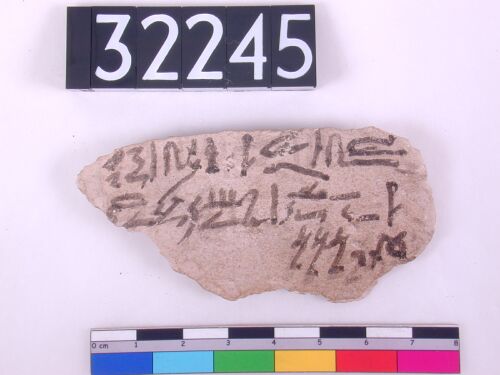
The Hieratic Script
The hieroglyphic script remained the anchor of writing in Egypt from the first writing in the late fourth millennium BC until the Roman Period. Its full forms, following the principles of formal Egyptian art, were suitable for monumental inscription and religious contexts - for the horizon of eternity, in which content expressed and secured what is good. For more everyday purposes, the full forms were not necessary, and already in the first centuries of writing the forms were simplified or abbreviated in less eternal contexts - for example, writing notes of contents on commodity storage or transport jars. Such notes of contents might be incised before or after firing onto the pottery surface, or written in carbon black pigment applied with a reed brush. The reed brush and the writing surface modified the forms of signs; many remain close to the hieroglyphic model, but most were so heavily altered that the cursive script is no longer recognisably the hieroglyphic script.

There are different degrees of cursiveness produced from writing with a brush: when the ancient Greeks wrote about Egypt in the fifth century BC and later, there were two main standardised cursive scripts - they called the less cursive of these the 'hieratic' script (meaning 'priestly'), because it was used for more sacred purposes such as copies of rituals and funerary literature, and they called the more cursive the 'demotic' script (meaning 'popular'), because it was used for more everyday purposes such as letters and accounts, and, increasingly, non-religious literature. The term hieratic really applies to the periods when demotic was in use, after about 700 BC. However, for convenience Egyptologists use the term hieratic for the less cursive script at all periods, even though, until 700 BC, it was used for everyday purposes as well as sacred purposes.
The hieratic script is a broad term, covering finer gradations of cursiveness, that can be defined by period and by purpose according to the following generalised categories:
During the Third Intermediate Period, hieratic continues to develop into two separate scripts, with literary Ramesside Hieratic leading to a standardised calligraphic style, Late Hieratic, and non-literary Ramesside Hieratic leading in Third Intermediate Period documentary handwriting in northern Egypt to demotic, and in the south to a highly cursive script sometimes called 'abnormal hieratic' in Egyptology (both developed by end of 8th century BC) (UC 33179, UC 33180). During the Twenty-sixth Dynasty, Demotic replaces the more cursive southern script, and Late Hieratic is used for religious manuscripts and, until the Thirtieth Dynasty, literary compositions.
See too the list of Petrie collection hieratic ostraca, mainly from Deir el-Medina
UC 32245: letter on an ostracon in fine mid-Eighteenth Dynasty hand 'said by the scribe Baki to his colleague the scribe Meh: bring me one strong bird !!!'

Copyright © 2002 University College London. All rights reserved.